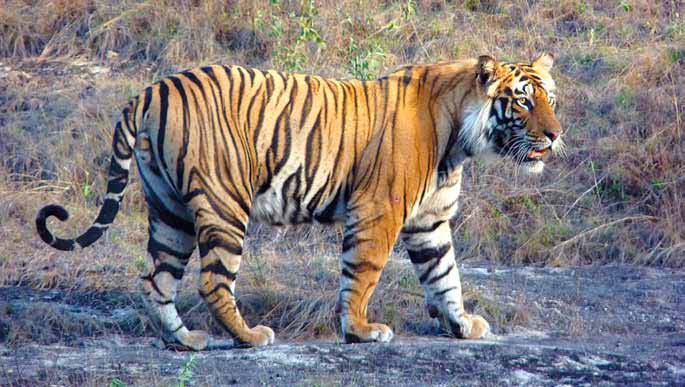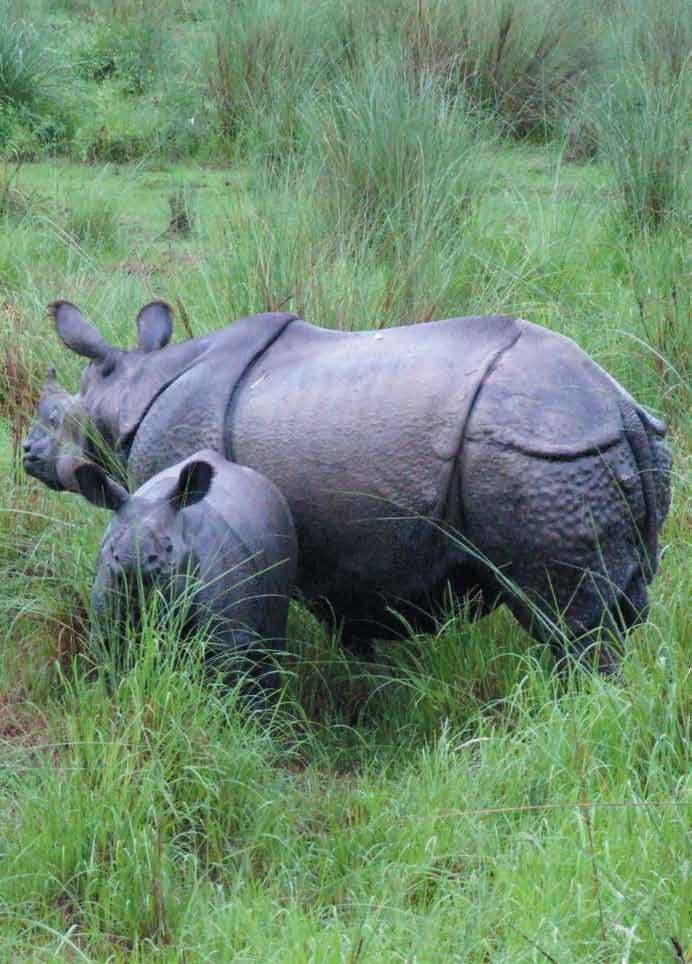
“Welcome to Chitwan. We’ll be leaving on the elephants for a jungle safari once the aircraft has departed, so please wait in the shade.” I greet the guests emerging from the Royal Nepal Airlines aircraft dazed by the bright April light, and usher them into the simple thatched shelter with wood plank benches that passed as the terminal.
With practised hands the bags are loaded onto the open Land Rover, as the prop engines keep spinning for a quick turnaround. A couple of stray dogs and several undernourished cattle are chased off the airstrip, and the flight lifts past us with a brief roar, heading back to Kathmandu. Silence settles back on the grass runway. A few locals who had paused to watch the daily spectacle return to their grazing goats. In faded cotton saris and glinting glass jewellery, two ladies cross the runway with firewood balanced high on their heads. It was 1974 and I had just started work at the famous Tiger Tops, the first jungle lodge in then-Royal Chitwan National Park. Airport duty was already my favourite task, meeting and despatching guests, and collecting the green mailbag on the daily flight from Kathmandu that was our sole link with the outside world. Chitwan is now connected with radio, telephone, and mobile, but in those distant days, bookings were received via telegrams and telex.
Chitwan National Park in southern Nepal off ers some of the best wildlife viewing in Asia and supports one of the subcontinent’s richest and most diverse ecosystems. The season to visit is during the autumn, winter, and spring months—September through to May. Tall alluvial grasslands, mixed riverine forest, and sal-covered Churia Hills dramatically regenerate every year with the onslaught of the summer monsoon rains. Banks erode, rivers change course, roads become impassable, and the vegetation surges in response to the heavy rainfall.
Fed by the Rapti and Narayani Rivers, historically, the fertile habitat was set aside by ruling Ranas and Shah kings as prime hunting country, reserved as a refuge to impress a favoured few royals, viceroys, and maharajahs. Originally protected as a sanctuary for Nepal’s greater one-horned rhinoceros, the fame of Chitwan National Park was soon usurped by the tiger’s elusive glamour, the undisputed star of the show. The king of the jungle is essentially nocturnal, solitary, and adept at avoiding people and encounters, their lone survival depending on self-sufficiency.
Arriving in Chitwan, I was told: “You can live your entire life in the jungle without ever glimpsing a tiger.” Encountering a tiger in the wild is a privilege not to be taken lightly, and an experience never forgotten. Today, Chitwan contains more tigers than the rest of Nepal’s protected areas put together, so you might be lucky. Hairs rise, breath stills, time stops, and the heart skips a beat as the sun dappled shadows dissolve into the largest of the world’s cats, several hundred kilos of sheer magnificence, elegant muscle, and striped intensity.
Throughout its range, Asia’s apex predator became critically endangered due to a combination of loss of habitat, depletion of prey species, human confl ict, and poaching and hunting. During Britain’s Queen Elizabeth’s state visit to Nepal in 1961, an elaborate and lavishly catered royal camp was carved out of the jungle, and over 300 elephants were rallied for the Chitwan game drive. Prince Philip refused to shoot, pleading a diplomatically injured hand. Yesterday’s hunters were evolving into today’s conservationists, and cameras were replacing guns.
On November 11, 1965, the first tourists arrived in Chitwan, a group of five Americans, who landed on the grassy Meghauli airstrip in a chartered Dakota DC-3. Their destination was a newly opened treetop lodge, then called Tiger Tops Hotel, in a clearing overlooking the Reu River near the Rapti confluence. Two Dallas oil millionaires, Toddy Lee Wynne Jr. and Herbert W. Klein, had found the site during the early 1960s. They charged their ‘white hunter’ guide, John Coapman, with building a place for visitors to enjoy the wildlife. The India-born son of American missionaries, Coapman was a colorful character who built the main lodge with an Africa-inspired conical thatched roof and four treetop bedrooms in a spreading silk cotton tree. Smooth river stones were collected for the floor, and wood, bamboo, and grass were gathered from the forest for walls and roofs. Innovative he may have been, but he was not very good at running a business.
On behalf of the Texan owners, in 1972, Jim Edwards and Dr. Chuck McDougal took over the management, rebranding Tiger Tops as a jungle lodge, expanding to 22 rooms and a tented camp, and emphasizing responsible tourism and conservation credentials. Naturalist guides were highly trained, an evening slide show oriented guests to environmental issues, filmmakers made wildlife documentaries, and research projects with the park authorities included tiger monitoring, camera trapping, and a gharial crocodile-breeding program. This was the beginning of nature tourism and ecotourism in Nepal


Nepal enjoys uniquely rich flora and fauna due to its dramatically diverse climates and countryside, with altitudes ranging from the earth’s highest peak of Mount Everest (Sagarmatha) at 29,028 feet (8,848 meters) to the lowland belt of the Terai at about 300 feet (100 meters) where Chitwan National Park is located. Over the years, the rich biodiversity, large mammals, and wealth of birdlife in the forests and grasslands of Chitwan have become a key feature of Nepal tourism, attracting 140,000 visitors last year. The park is easily accessible, just half-an[1]hour’s fl ight from Kathmandu to Bharatpur airport, or a fi ve-hour drive through the scenic Himalayan middle hills. There are dozens of beautiful lodges and camps to choose from to suit all pockets— since 2012, when the seven lease concessions were not renewed, including the pioneer Tiger Tops, all the accommodation is on the perimeter of the protected area. Guest programs include visits to adjacent villages, visitor centers, local museums, and cultural shows.
Nepal’s Department of National Parks and Wildlife Conservation can be proud of its well-protected parks and successful conservation record. Recovery of Nepal’s wild tigers is well ahead of the global target by tiger range countries to double the world’s population by 2022. Nepali scientists have trained neighbors in scientific counting methods, contributed sustainable tourism recommendations, and naturalists have created conservation awareness with tourists as well as visiting celebrities. Hollywood’s Orlando Bloom came for UNICEF, Cameron Diaz and Eva Mendes for World Wildlife Fund, and Bob Hoskins got too close for comfort whilst making a tiger documentary. Leonardo di Caprio’s passion for conservation was first ignited in Nepal, resulting in millions of dollars of support for the tiger.
For three years, I lived in Chitwan, and the pattern of wildlife activities is little changed. Days in the jungle involved early starts in my khaki green uniform, seeing guests off on wildlife safaris, naturalist-guided walks, or peaceful boat trips down the rivers that fl ow gently downstream into the Ganga. Trips to the domestic elephant camp demonstrated their careful husbandry, often followed by an afternoon Land Rover drive in open vehicles through the park tracks, with me at the wheel. My young son’s first spoken word was not Mum or Dad, but hathi, meaning elephant in Nepali.
Captivated by the remote beauty of Nepal’s Terai jungle and the persuasiveness of tourism and conservation, that first month I savored the excitement of exploring tiger country. I bonded with the staff when the kitchen thatch caught fi re and my height helped them hoist up the chain of water buckets from the river to the team on the roof. The lodge community numbered about two hundred, and dressed in shades of buff and khaki, we were a self-contained community, with lives defined by our jobs. Like living on a ship, I used to think, sailing in a sea of dense green trees.
The Nepali and Indian naturalists taught me a lot, and I can conjure up the smell of hot swishing elephant grass on an afternoon ride in search of rhinos and whatever else could be found—a glossy chital stag, a grey langur monkey quizzically aloft, or the brilliant fl ash of a peacock. I was charged by an irate rhino and baby whilst out on foot, saved by Sultana, a smart elephant driver on Roop Kali, who chased her safely into the woodland. Despite being a perilously close encounter, I was hooked on the wild thrill of Chitwan jungle life.
I still am, and hope you will be, too
Source: SHANGRI~LA | In-flight Magazine January- March 2017

